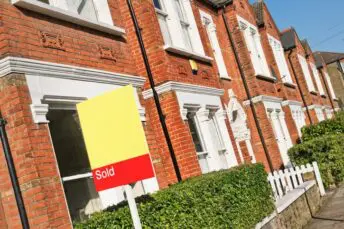House Price Watch Sept 2023
House prices held steady this month while annual house price growth edged downwards. Market activity is subdued with demand a third lower than the five year average and house price growth and transactions at a ten year low. Borrowing costs are the main factor. The modest reduction in house prices is not enough to offset the higher cost of borrowing, so downward pressure on house prices is expected into next year. It is increasingly a buyer's market with reports of 80% more homes for sale than two years ago and the proportion of homes for sale finding a buyer down 25%.
What’s happening nationally
House prices remained stable over the past month and are down on average -3.3% in the past year.
Land Registry and Rightmove noted a slight increase in house prices over the past month, Nationwide reported stable house prices and Halifax a slight fall in monthly house prices. Land Registry shows a continued slowing of annual house price growth and Nationwide, Halifax and Rightmove all report a fall in annual house price growth.
Indices based on:
Land Registry – registered property transactions in August.
Nationwide & Halifax – mortgage valuations in September.
Rightmove – asking prices posted on Rightmove in September
*Rightmove is not included in the index average as the basis for its index is different (asking price vs agreed sale price)
| Index reports: | Monthly change | Annual change |
|---|---|---|
| Land registry | +0.3% | +0.2% |
| Nationwide | 0.0% | -5.3% |
| Halifax | -0.4% | -4.7% |
| Rightmove | 0.4% | -0.4% |
| Average change | 0% | -3.3% |
House prices in your area
House prices fluctuated over the past month — up in some areas and down in others. However, the annual rate of house price growth continues to slow in all areas and is in negative terriorty in the East of England (-1.6%), London (-1.4%), South West (-1.1%), South East (-0.6%) and Wales (-0.1%).
Average house prices remain highest in London (£536K) and lowest in the North East (£165K).
House price growth is slightly higher for properties that are detached (+0.8%) or semi detached (+0.9%) and slightly lower for properties that are terraced (-0.9%) or flats/ maisonettes (-0.2%) according to August Land Registry data.
| UK Region | Average price £ | Monthly change | Annual change |
|---|---|---|---|
| England | |||
| Nothern Ireland | |||
| Scotland | |||
| Wales | |||
| North West | |||
| Yorkshire and The Humber | |||
| North East | |||
| West Midlands | |||
| East Midlands | |||
| South West | |||
| East of England | |||
| South East | |||
| London |
| UK City | Average price | Annual change |
|---|---|---|
Market Monitor
There were 87K transactions in August, up 1% on July, 16% lower than August 2022. 87K transactions is in the lowest range we have seen in the last decade.
Demand continues to fall as do new instructions from sellers this month. Average stock per agent is up month on month.
Evidence of a buyers’ market continues with Zoopla reporting that buyers are benefiting from 80% more homes for sale than two years ago and Rightmove reporting that the proportion of homes finding a buyer has dropped from eight in every ten (from the height of the market) to six in every ten — a 25% fall.
Time to sell has increased to 59 days up from 57 days last month and above the 12 month average of 50 days.
How busy is the market?
- Not busy
- Normal
- Very busy
- Transactions up in August, but remain at ten year low
- Total transactions in August 87K
- +1% from last month
- -16% from August last year
Homes for sale vs homebuyers
- Good availability of homes
- Normal
- Shortage of homes
- Buyer enquiries continue to fall(-39% RICS); demand continues to fall
- Seller enquiries down (-17% RICS); sales instructions continue to fall
- Average stock per agent 54; up from 53 last month (incl under offer/ Sold STC Rightmove)
Average speed of sale
- Fast
- Normal
- Slow
- 59 days to find a buyer, up from 57 days last month (12 month average 50 days Rightmove)
What the experts say
Rightmove - agent's view

“In a month of subdued housing market activity, the average asking price of newly marketed properties increases a little to £366,281 (+0.4%). Prices have risen at this time of year in all but three of our September reports since we began reporting back in 2001, and it is smaller than the average of 0.6% recorded in the same period over the past ten years. While some sellers are clearly being too optimistic on their pricing, it does appear that others are listening to their agents’ advice to price correctly from the outset. The proportion of homes that are finding a buyer has dropped from eight in every ten at the height of the frenzy, to a more subdued sales rate of six in every ten, making pricing competitively more critical to really stand out.”
Nationwide

“Annual house price growth was unchanged in September. Housing market activity remains weak, with just 45,400 mortgages approved for house purchase in August, c.30% below the monthly average prevailing in 2019 before the pandemic struck. This relatively subdued picture is not surprising given the more challenging picture for housing affordability. For example, someone earning an average income and purchasing the typical first-time buyer home with a 20% deposit would spend 38% of their take home pay on their monthly mortgage payment – well above the long-run average of 29%. With the Bank Rate not expected to decline significantly in the years ahead, borrowing costs are unlikely to return to historic lows seen after the pandemic. Instead, it appears more likely that a combination of solid income growth with modestly lower house prices and mortgage rates will gradually improve affordability over time, with housing market activity remaining fairly subdued in the interim.”
Halifax

“UK house prices edged down by -0.4% on a monthly basis. The average home now costs £278,601, a drop of around £1,200 since last month. Nonetheless they remain some £39,400 higher than in March 2020, such was the extraordinary growth seen during the pandemic. Activity levels continue to look subdued. Borrowing costs are the primary factor, given the impact of higher interest rates on mortgage affordability. Against this backdrop, homeowners inevitably become more realistic about their target selling price, reflecting what has increasingly become a buyer’s market. Many economists and financial markets predict the Base Rate will remain higher for longer, with any significant cuts appearing unlikely until inflation gets closer to the Bank of England’s 2% target. Overall, these factors are likely to keep mortgage rates elevated in comparison to recent years, constraining buyer demand and putting downward pressure on house prices into next year.”
Zoopla (Hometrack)

“Our index has recorded a 0.5% price fall over the last year – the first annual decline for over a decade – since June 2012. House price falls have been modest over the last year despite the hit to buying power. Many households have delayed moving while more fixed-rate loans, tougher affordability testing and a robust jobs market means there are few forced sellers in the market. The modest reduction in house prices is not sufficient to boost affordability and support a recovery in sales volumes, even if mortgage rates were to dip below 5%. We should expect further modest downward pressure on prices over Q4 2023 and into Q1 2024. It remains a buyer’s market with purchasers benefitting from 80% more homes for sale than in September 2021. The discount to the asking price for newly agreed sales now averages 4.2% or £12,125 off the original asking price. This is the highest level since March 2019.”
RICS

“The September 2023 RICS UK Residential Survey results continue to depict a challenging market backdrop, with stretched mortgage affordability still the dominant factor weighing on buyer demand. While the near-term outlook remains relatively downbeat, twelvemonth sales expectations have at least stabilised of late. Perhaps linked to this, anecdotal comments left by contributors suggest that the Bank of England’s decision to pause monetary policy tightening last month has provided a little bit of support to market sentiment.”




